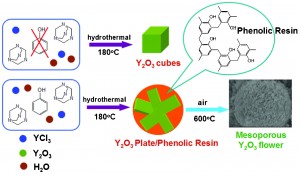Posted on behalf of Gwenda Kyd, web writer for CrystEngComm
Biofuels, such as plant oils, are a potential alternative energy source. However, the presence of impurities like gums and phospholipids can hamper their use in diesel engines. Phospholipids (which are made up of a fatty acid, a simple organic group and a phosphate group) can be removed in the conventional refining process, but this causes loss of oil and nutrients and uses both water and chemicals.
A new paper shows how phospholipids can be efficiently removed using Y2O3 cubes and flowers, made hydrothermally, as shown in the figure below. Y2O3 is a Lewis acid and the positively charged metal atom attracts the negatively charged phospholipid, absorbing it onto the metal-oxide surface. Y2O3 flowers have a larger specific surface area than cubes, so absorb phopholipds more efficiently (approximately 90% rather than 80% of 870 ppm phospholipid in soyabean oil). This demonstrates that both flowers and cubes could have potential use in the separation of phospholipids from plant oils.
For more information see the paper at:
Hydrothermal synthesis of Lewis acid Y2O3 cubes and flowers for the removal of phospholipids from soybean oil
Yi-Feng Lin, Jhen-Huei Chen, Shih-Hong Hsu and Tsair-Wang Chung
CrystEngComm, 2013, Advance Article
DOI: 10.1039/C3CE40791H, Paper
 Gwenda Kyd has a PhD in metallocarborane chemistry from the University of Edinburgh. Other research work includes the spectroscopic study of the structure of glasses and organometallic electron-transfer reactions and the preparation of new inorganic phosphors. Currently she works as a scientific database editor.
Gwenda Kyd has a PhD in metallocarborane chemistry from the University of Edinburgh. Other research work includes the spectroscopic study of the structure of glasses and organometallic electron-transfer reactions and the preparation of new inorganic phosphors. Currently she works as a scientific database editor.











